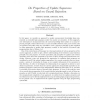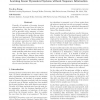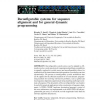3032 search results - page 5 / 607 » Complexity of sequences and dynamical systems |
TPLP
2002
13 years 7 months ago
2002
In this paper, we consider an approach to update nonmonotonic knowledge bases represented as extended logic programs under the answer set semantics. In this approach, new informat...
ICS
2010
Tsinghua U.
14 years 4 months ago
2010
Tsinghua U.
Computation in the physical world is restricted by the following spatial locality constraint: In a single unit of time, information can only travel a bounded distance in space. A ...
ICANN
2009
Springer
14 years 2 days ago
2009
Springer
The sequential structure of complex actions is apparently at an abstract “cognitive” level in several regions of the frontal cortex, independent of the control of the immediate...
ICML
2009
IEEE
14 years 2 months ago
2009
IEEE
Virtually all methods of learning dynamic systems from data start from the same basic assumption: that the learning algorithm will be provided with a sequence, or trajectory, of d...
WOB
2004
13 years 8 months ago
2004
ABSTRACT. Reconfigurable systolic arrays can be adapted to efficiently resolve a wide spectrum of computational problems; parallelism is naturally explored in systolic arrays and r...



